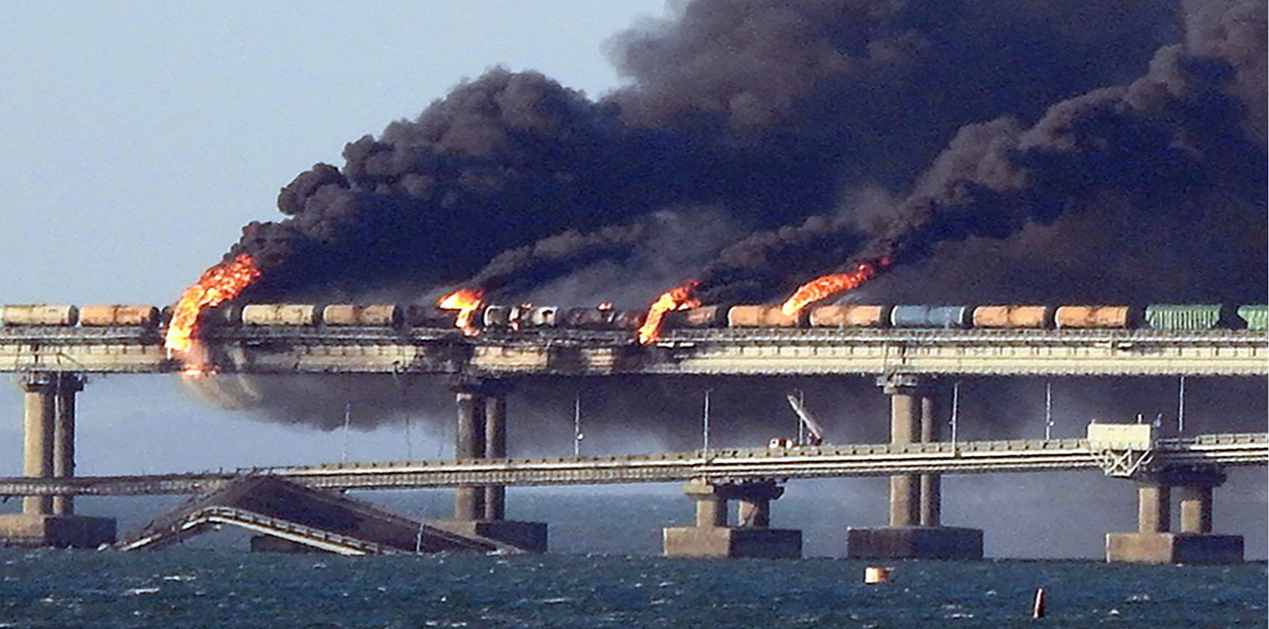Russia-Ukraine War 2022 is emphasizing on a time-worn question: what is the balance between political control and military operational expertise in deciding military strategy? Consequent to the attack on Kerch Bridge, Russia struck with high-precision long-range air and sea-based weapons and “kamikaze” drones at military command facilities and Ukraine's energy and water supply system. Drones flying low over buildings in Kyiv city, announced their arrival with a hum adding tremors of terror. This became the true newer face of this war. Ukraine suspended electricity exports to the EU through dedicated lines to Moldova and Poland following Russian missile strikes. President Volodymyr Zelenskyy stated that 30 percent of Ukraine’s power stations had been destroyed in drone attacks since October 10, leading to “massive blackouts” across the country.
The strategy behind Russia’s latest warfare is evident. In bombing Ukraine’s critical civilian infrastructure, including energy facilities, the Russian army has clearly disrupted infrastructure of heat, electricity and water supply as the winter approaches. Russia's Defence Ministry stated that it had carried out a large-scale attack on military targets and energy infrastructure and depots storing foreign-supplied military weapons and equipment across Ukraine using high-precision weapons, neutralising "all designated targets."
The point herein is that at the commencement of the war and the initial two months saw over 2000 missiles fired against Ukraine by the Russian Armed Forces. These studiously and deliberately avoided targeting energy infrastructure, rail-road-bridges network, national command and control establishments and the like, even at the face of serious reversals in Kyiv, Kharkiv regions or the sinking of Moscova! The seeming red-line was breached in the targeting of the Kerch Bridge allegedly by Ukraine, in the 34th week of the war! The current continuing onslaught clearly indicates that the plethora of infrastructural targets recently hit by stand-off missiles/ drones were pre-registered and available to the designated missile units, though not deliberately executed since February 2022. The summation of the argument is that the Russian Military Forces in the conduct of their military campaign against Ukraine for over eight months had political restrictions and strict control on what to target, with what and when!
Learning lessons of wars is very essential, for military history provides the context in social, cultural, economic, human, moral, political, and psychological circumstances that helps to make informed decisions. Failure to study context of wars, may lead to lessons and conclusions divorced from their proper circumstance. Taking recourse to history, Sun Tzu in the Art of War, 4th century BC, had opined that the decision to go to war must be a political decision, but that the general must be free to act autonomously once that decision is made. In deliberating on his insight of “war being a continuation of policy,” Clausewitz however argued for extensive political influence over military operations. Sir Michael Howard had rightly prophesized that "the roots of victory and defeat often have to be sought far from the battlefield." Gen Douglas MacArthur in the famous “Old soldiers never die” speech to the US Congress, stated that, “Once war is forced upon us, there is no alternative but to apply every available means to bring it to a swift end. War’s very object is victory—not prolonged indecision.” Gen MacArthur’s position left no room for political factors to moderate a conflict once it has begun.
Can such political guidance to the military cross the line and becomes interference, is also a moot question? In India, the past seven and half decades are full of discourses that have constantly led to ‘what if’ questions! For example, ‘what if’ Indian Army was allowed to continue advance in 1948 to Kotli-Mirpur, Muzaffarabad and Skardu, or ‘what if’ IAF was permitted to be utilised offensively in 1962 or across the LOC in 1999! It is understood that political diktats are based on information from multiple sources, and judgements are made on deep analytical thought. Many decisions are based on inherent dilemma of avoidance of escalation of war, which either way cannot be assured of! Even if Operation Swift Retort was thwarted and grossly underachieved, it undeniably happened, and could have lead to escalation!
Fact of the matter is, in future too, political judgements will be made, that may or may not conform to military planners’ conceptualisation of oncoming or ongoing war. India’s political aims, analysis of future scenarios and end game visualised will essentially determine everything – the military concepts and strategy, the force capabilities mandatory and organisational structures and limitations or constraints in achievement of task. While it is imperative that the polity formally informs the military leaders what is desired in peace time, it is also incumbent on the military leaders to seek clarity of the political objective if it isn’t clear. As an example, the Overall Force Commander of IPKF, Gen Depinder Singh writes in his book, ‘The IPKF in Sri Lanka’ that the directive issued by the Government to the first Overall Force Commander of the IPKF in 1987 was ‘delightfully vague’, directing to ‘implement the Accord.’
Another issue is considering Clausewitz’s argument that the political purpose must guide the conduct of the war is that the purpose may change during the course of a conflict. With two decades behind the expensive war in Afghanistan which was going nowhere, the US and NATO forces were pulled out by political fiat in August 2021, with Taliban, an organisation they had fought over two decades, regaining control. In Russia’s Ukraine campaign in February-March 2022, with Ukraine not having capitulated and the stalemate, the political direction would have been to jettison the campaign against Kyiv-Sumy region and reinforce operations at Donbas and Kherson/Zaporizhzhia! Similarly in the last two weeks, the Russian campaign changed tack completely, with focussed targeting of Ukrainian national infrastructure. Obviously once a war begins, alterations in the course of war can change even political views and aspirations, like in 1971 India-Pak war in East Pakistan, capture of Dacca was given a go ahead during the campaign, though initially not planned for.
In Prof Samuel Huntington's book The Soldier and the State; “objective control” of military had greatly influenced civil-military relations for more than six decades clearly defining division of responsibility between the military and the civilian leadership. The military focuses on cultivating expertise in the “management of violence” and avoids the civilian preserve of politics and policy decision-making. This approach as per Huntington was ideal because it ensured both military deference to civilian authority and the country's military effectiveness in war. Civilian leaders provide guidance to military leaders about their objectives in armed conflicts, and military leaders provide advice about military options to achieve the objectives. Again the political leaders have the veto to accept or reject the options! In the Huntington model, relations between civilians and the military are essentially transactional. However, in the current system of political-military relations, these ought to be constantly collaborative.
It can be said that there are no parallels between Russia-Ukraine and India and her adversaries. However, in policy considerations it is apparent that military plans even in India are subordinate to the political vision and directions thereof, before, during and after the campaign. Since war is an act of policy, political considerations will dominate the conduct of war. With controlled defence budgets, sprint in military technologies, the continued obstinacy of the two adversaries and their collusion, India has to have an enunciated military strategy that guides creation of the right future force and capabilities. It is hence essential that the politico-bureaucratic establishment involves with the military strategies in peacetime based on logical, conceivable scenarios and end-games. The military planners without the political guidance may prepare for inconceivable wars and methodology in conduct of operations. As an example, if the political establishment contemplates that there should be caution early on in the campaign to undertake strategic interdiction against adversaries’ national infrastructure; such a caveat could envisage a change in military strategy. It is logical hence to pre-define military strategy duly by the political establishment, the method to conduct a campaign, end or likely ends before any war begins.
There is a need to contextualise the issues raised herein. The armed forces are an expensive proposition for any nation, especially so for developing India, with serious competing socio-economic commitments. This must be cumulated with hot and tense borders and the unyielding, inflexible mind-set of the adversaries who threaten the sacred territory! The likelihood of improved relationship with the adversaries cannot be assured and is not on the horizon. The situation therefore beckons Indian political-military hierarchy to envision and prognosticate on the salience, typology and manifestation of threat and challenges of modern conventional war, the political goals and the options for achievements of those. The military strategy so created will define the capabilities in the form of focussed acquisition, training and deployment of military forces and the national will or declared intent and resolve. The creation of these capabilities and the enunciation of the national will through the military strategy would convey the right communication to the potential adversary.
(The paper is the author’s individual scholastic articulation. The author certifies that the article/paper is original in content, unpublished and it has not been submitted for publication/web upload elsewhere, and that the facts and figures quoted are duly referenced, as needed, and are believed to be correct). (The paper does not necessarily represent the organisational stance... More >>
Image Source: https://www.ft.com/content/453d8aff-b8f2-42a3-919b-10a327475dfb (Credit: AFP - Getty Images)











Post new comment